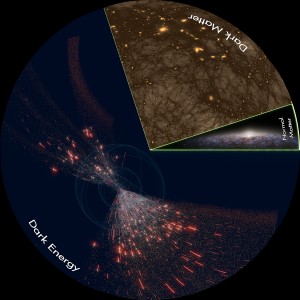Dark Universe
Posted on May 6, 2014 at 1:10 pm
B+| Lowest Recommended Age: | All Ages |
| MPAA Rating: | Not rated |
| Profanity: | None |
| Alcohol/ Drugs: | None |
| Violence/ Scariness: | None |
| Diversity Issues: | None |
| Date Released to Theaters: | May 2, 2014 |
 “Dark Universe,” currently playing in the planetariums at The Einstein Planetarium of the Smithsonian’s Air and Space Museum, the American Museum of Natural History in New York City, and the California Academy of Sciences in San Francisco, is a thrilling journey to the outer edges of the universe narrated by “Cosmos” super-scientist Neil deGrasse Tyson. It’s like a grown-up ride on the magic school bus, taking us into the deepest questions of who and what and where we are, with images based on data from NASA and European Space Agency missions, ground-based telescopes, supercomputer simulations, and research conducted at institutions around the globe. In other words, this is the stuff the “Big Bang Theory” guys get so excited about in between visits to the comic book store and takeout food.
“Dark Universe,” currently playing in the planetariums at The Einstein Planetarium of the Smithsonian’s Air and Space Museum, the American Museum of Natural History in New York City, and the California Academy of Sciences in San Francisco, is a thrilling journey to the outer edges of the universe narrated by “Cosmos” super-scientist Neil deGrasse Tyson. It’s like a grown-up ride on the magic school bus, taking us into the deepest questions of who and what and where we are, with images based on data from NASA and European Space Agency missions, ground-based telescopes, supercomputer simulations, and research conducted at institutions around the globe. In other words, this is the stuff the “Big Bang Theory” guys get so excited about in between visits to the comic book store and takeout food.
Galileo shocked the people of the 17th century when he told them that the earth was not the center of the solar system. In the centuries since, we have recalibrated again and again, finding out solar system is not the center of the galaxy — there is no center — and that normal matter—the atoms that we are made of—is a tiny fraction of the mass and energy in the cosmos, less than five percent. Our notion of ourselves as primary in creation is profoundly rebutted.
Watching this film in a planetarium, we feel that we can travel through space as well as through the grand ideas Dr. Tyson describes. This brief glimpse into what we have learned and what we hope to learn next is a thrilling opportunity to expand our notions of how small we are in the great scheme of existence but also how large we are in our ability to begin to comprehend the universe and our place in it.
